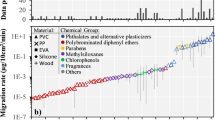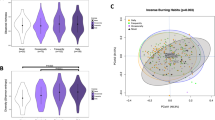Abstract
Young children may be more likely than adults to be exposed to pesticides following a residential application as a result of hand- and object-to-mouth contacts in contaminated areas. However, relatively few studies have specifically evaluated mouthing behavior in children less than 5 years of age. Previously unpublished data collected by the Fred Hutchinson Cancer Research Center (FHCRC) were analyzed to assess the mouthing behavior of 72 children (37 males/35 females). Total mouthing behavior data included the daily frequency of both mouth and tongue contacts with hands, other body parts, surfaces, natural objects, and toys. Eating events were excluded. Children ranged in age from 11 to 60 months. Observations for more than 1 day were available for 78% of the children. The total data set was disaggregated by gender into five age groups (10–20, 20–30, 30–40, 40–50, 50–60 months). Statistical analyses of the data were then undertaken to determine if significant differences existed among the age/gender subgroups in the sample. A mixed effects linear model was used to test the associations among age, gender, and mouthing frequencies. Subjects were treated as random and independent, and intrasubject variability was accounted for with an autocorrelation function. Results indicated that there was no association between mouthing frequency and gender. However, a clear relationship was observed between mouthing frequency and age. Using a tree analysis, two distinct groups could be identified: children ≤24 and children >24 months of age. Children ≤24 months exhibited the highest frequency of mouthing behavior with 81±7 events/h (mean±SE) (n=28 subjects, 69 observations). Children >24 months exhibited the lowest frequency of mouthing behavior with 42±4 events/h (n=44 subjects, 117 observations). These results suggest that children are less likely to place objects into their mouths as they age. These changes in mouthing behavior as a child ages should be accounted for when assessing aggregate exposure to pesticides in the residential environment.
This is a preview of subscription content, access via your institution
Access options
Subscribe to this journal
Receive 6 print issues and online access
$259.00 per year
only $43.17 per issue
Buy this article
- Purchase on Springer Link
- Instant access to full article PDF
Prices may be subject to local taxes which are calculated during checkout


Similar content being viewed by others
References
Cohen Hubal EA Sheldon LS Burke JM McCurdy TR Berry MR Rigas ML Zartarian VG Freeman NCG Children's exposure assessment: a review of factors influencing children's exposure, and the data available to characterize and assess that exposure, Environ Health Perspect (2000a) 108(6): 475–486
Cohen Hubal EA Sheldon LS Zufall MJ Burke JM Thomas KW The challenge of assessing children's residential exposure to pesticides, J Expos Anal Environ Epidemiol (2000b) 10: 638–649
Davis S Myers PA Kohler E Wiggins C Soil Ingestion in Children with Pica: Final Report 1995 EPA Cooperative Agreement CR 816334-01
Fagot B Hagan R Is what we see what we get? Comparisons of taped and live observations, Behav Assess (1988) 10: 367–374
Freeman NCG Susceptibility of children related to differential exposure and/or dose. Workshop presentation, The Role of Human Exposure Assessment in the Prevention of Environmental Disease. Doubletree Hotel, Rockville, MD September 22–24, 1999
Groot ME Lekkerkerk MC Steenbekkers LPA Mouthing Behavior in Young Children: An Observational Study. Agricultural University Wageningen, Wageningen, The Netherlands 1998
Juberg DR Alfano K Coughlin RJ Thompson KM An observational study of object mouthing behavior by young children, Pediatrics (2001) 107(1): 135–142
Lepow ML Bruckman L Rubino RA Markowitz S Gillette M Kapish J Role of airborne lead in increased body burden of lead in Hartford children, Environ Health Perspect (1974) 7: 99–102
Lepow ML Bruckman L Gillette M Markowitz S Rubino R Kapish J Investigations into sources of lead in the environment of urban children, Environ Res (1975) 10: 415–426
Lewis RG Fortune CR Blanchard FT Camann DE Movement and deposition of two organophosphorus pesticides within a residence after interior and exterior applications, J Air Waste Manage Assoc (2001) 51: 339–351
Madden NA Russo DC Cataldo MF Environmental influences on mouthing in children with lead intoxication, J Pediatr Psychol (1980) 5(2): 207–216
Reed KJ Jimenez M Freeman NCG Lioy PJ Quantification of children's hand and mouthing activities through a videotaping methodology, J Expos Anal Environ Epidemiol (1999) 9: 513–520
Ruff HA Infants' manipulative exploration of objects: effects of age and object characteristics, Dev Psychol (1984) 20(1): 9–20
Ruff HA Dubiner K Stability of individual differences in infants' manipulation and exploration of objects, Percept Mot Skills (1987) 64(3 Pt 2): 1095–1101
Update to the Residential SOPs dated February 22, 2001 (Policy 12)
US EPA Summary Report of the Technical Workshop on Issues Associated with Considering Developmental Changes in Behavior and Anatomy when Assessing Exposure to Children EPA/630/R-00/005 December 2000
Zartarian VG Streicker J Rivera A Comejo CS Molina S Valadez OF Leckie JO A pilot study to collect micro-activity data of two- to four-year-old farm labor children in Salinas Valley, California, J Expos Anal Environ Epidemiol (1995) 5(1): 21–33
Zartarian VG Ferguson AC Leckie JO Quantified dermal activity data from a four-child pilot field study, J Expos Anal Environ Epidemiol (1997) 7(4): 543–553
Acknowledgements
The authors thank Scott Davis and Dana K. Mirick for sharing the data from their study, as well as insightful comments on the manuscript. This work has been funded wholly by the US Environmental Protection Agency under EPA Cooperative Agreement CR 816334-01 to the FHCRC. It has been subjected to agency review and approved for presentation and publication. Mention of trade names or commercial products does not constitute endorsement or recommendation for use.
Author information
Authors and Affiliations
Corresponding author
Rights and permissions
About this article
Cite this article
TULVE, N., SUGGS, J., MCCURDY, T. et al. Frequency of mouthing behavior in young children. J Expo Sci Environ Epidemiol 12, 259–264 (2002). https://doi.org/10.1038/sj.jea.7500225
Received:
Published:
Issue Date:
DOI: https://doi.org/10.1038/sj.jea.7500225
Keywords
This article is cited by
-
Concurrent Assessment on Blood Lead in Young Children and Toy Lead in Shanghai
Exposure and Health (2023)
-
Children’s exposures to boron and biocides from slime products in Asian regions
Journal of Exposure Science & Environmental Epidemiology (2022)
-
Potentially toxic elements pose significant and long-term human health risks in river basin districts with abandoned gold mines
Environmental Geochemistry and Health (2022)
-
Organophosphate esters in children and adolescents in Liuzhou city, China: concentrations, exposure assessment, and predictors
Environmental Science and Pollution Research (2022)
-
A quest to identify suitable organic tracers for estimating children’s dust ingestion rates
Journal of Exposure Science & Environmental Epidemiology (2021)



